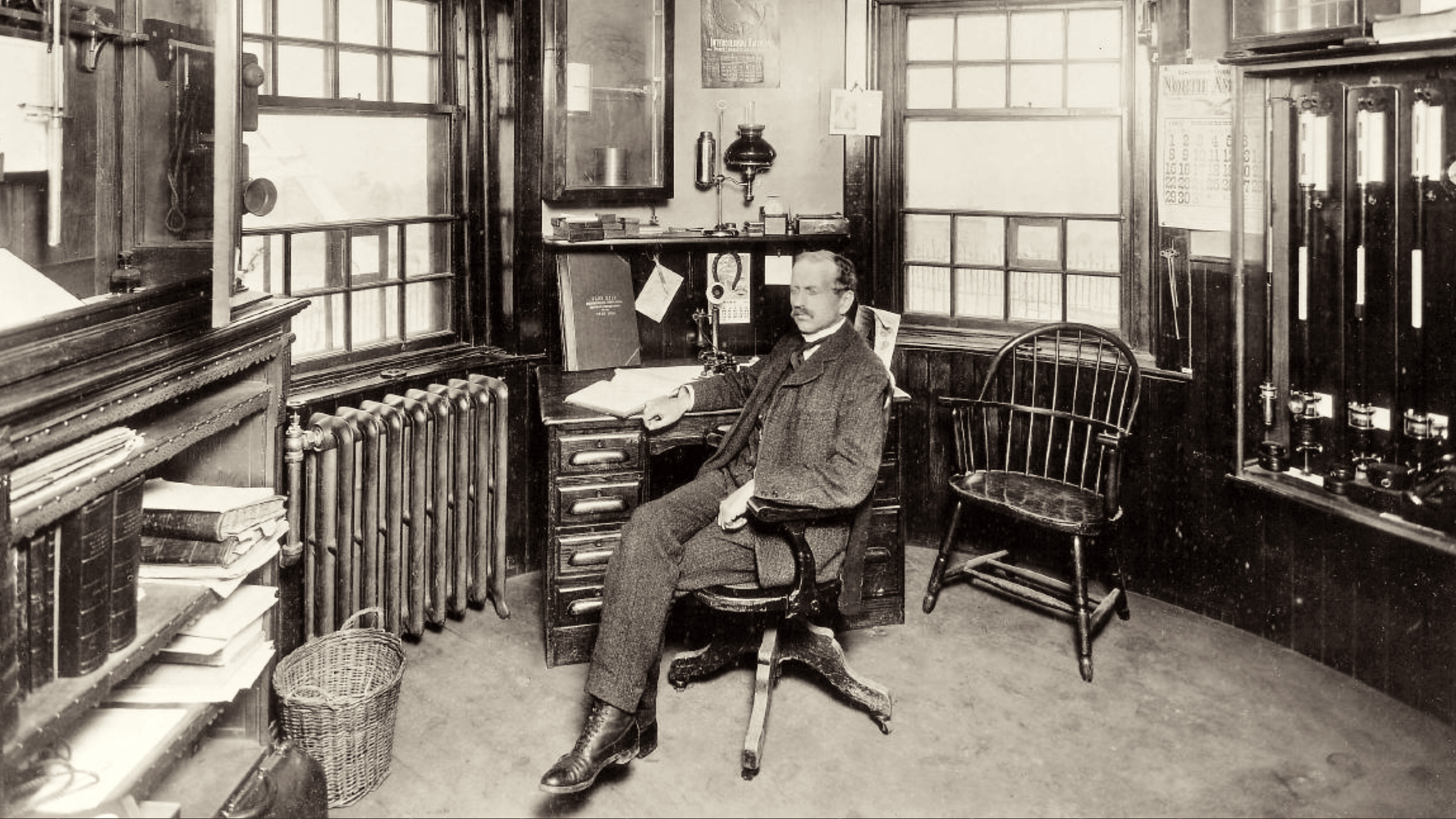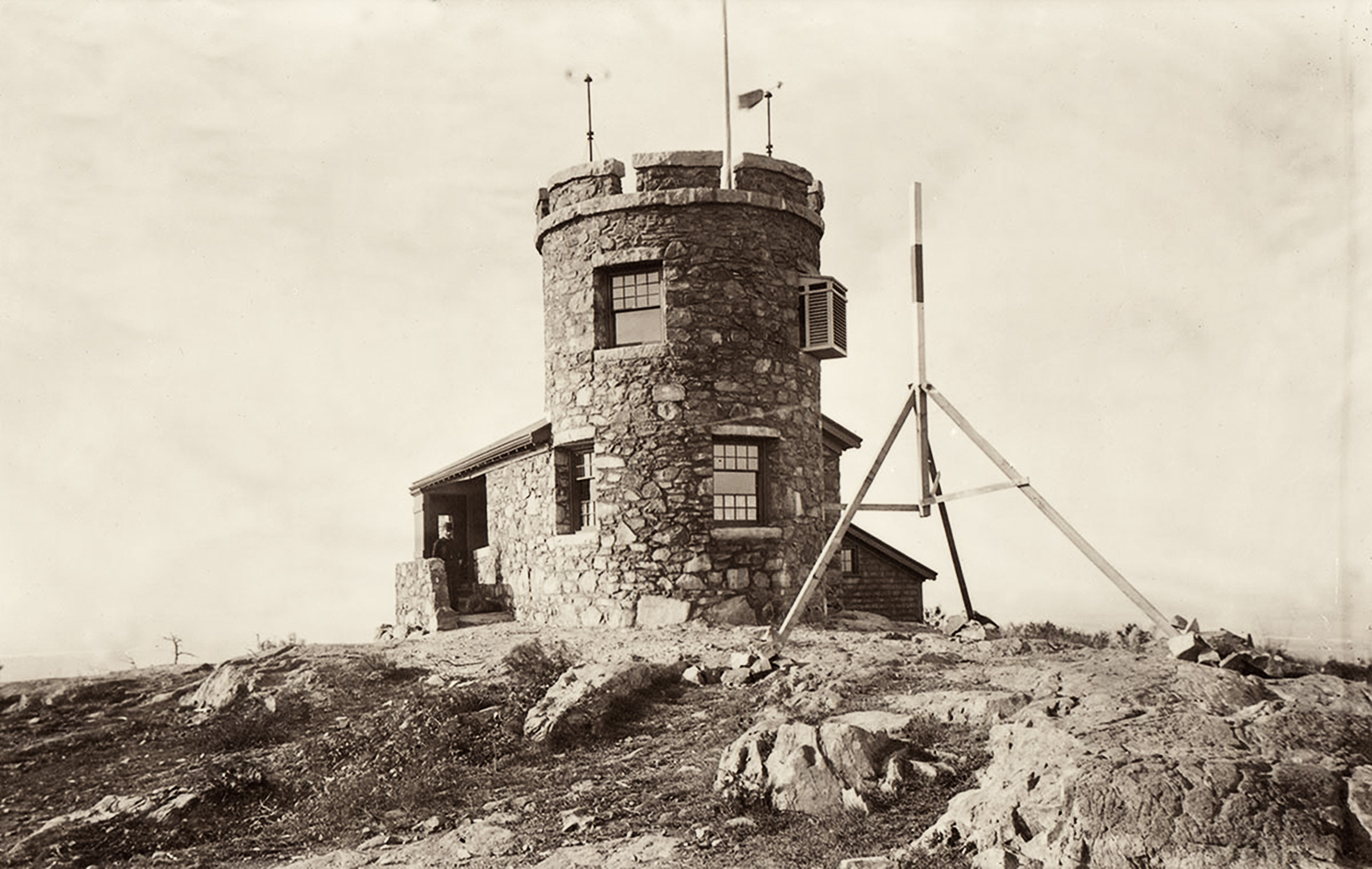Kites, balloons, and blueberries
For 137 years, a weather observatory started by an MIT graduate has used low-tech methods to study the atmosphere and monitor climate change.

On November 4, 1878, Abbott Lawrence Rotch stood behind his family’s home at 3 Commonwealth Avenue in Boston and looked up toward the sky. The day was fair, the 17-year-old noted, and the sky clear. He recorded the information as part of the first entry in his weather diary. In the years to come, recording and studying the weather would become an all-encompassing pursuit for Rotch. But as he peered into the bright sky on that fall day, he could not have known that over a century later, his work would be foundational for the field of climatology.
As a descendant of prominent merchants and politicians, Rotch had a privileged childhood. His family took long trips to Europe, going mountain climbing in Austria and spending evenings at the opera. Always curious, at 16 he tried (unsuccessfully) to develop new ways of performing arithmetic with logarithm tables. He also constructed his own slide rule out of cardboard and attempted (also unsuccessfully) to cure a cold by fasting for two days.
In 1880, Rotch enrolled at MIT. Although he studied mechanical engineering, his fascination with weather persisted. He kept up his weather diaries and once wrote an article for the Tech debunking his fellow students’ claims that the previous winter had been unusually cold. (He did concede that it had been quite dark and gloomy.)
While Rotch was at MIT his father died, leaving him a sizable inheritance that meant he didn’t need to work after he graduated in 1884. Nor was he enthusiastic about engineering. But without an occupation, he felt listless. So in July of 1884, when Rotch decided to climb Blue Hill in Milton, Massachusetts, he hoped the walk would be rejuvenating.

For weeks afterward, Rotch thought about the unobstructed vantage point that the top of Blue Hill provided for observing the weather. He wrote in his diary that he was considering constructing a weather observation station at the hill’s summit to study questions that had long occupied his mind, like how elevation affects wind speed and precipitation. Town officials and Rotch’s mentors from MIT encouraged him to pursue the plan. Working with his architect brother, Rotch oversaw construction of a two-story stone tower, with an observing platform on the top, attached to a two-bedroom living space, all of which cost $3,500 to build. (Because the Milton town line bisects the top of the hill, the tower is situated in Milton and the living quarters in Canton.) On January 31, 1885, fireworks marked the official opening of the Blue Hill Observatory. Rotch moved into one of its two bedrooms while MIT student Willard Gerrish, Class of 1887, whom Rotch had hired to help with his research, moved into the other.
Long-term data sets such as the observatory’s are like decoders that let scientists read climate records kept by nature, like the width of tree rings and the composition of sediment layers.
Weather forecasting was in its infancy when Blue Hill was founded. The telegraph had been invented about 40 years earlier, giving meteorologists the ability to communicate quickly between disparate locations—a prerequisite for predicting how storms will evolve. But Don McCasland, today’s program director at Blue Hill Observatory, thinks Rotch’s early goals went beyond simply learning to predict the weather. Rotch wanted to understand the inner workings of the atmosphere—“all the layers of the atmosphere,” says McCasland.
In pursuit of this goal, Rotch and several assistants used kites and balloons to send meteorological instruments into the sky. In 1894, along with journalist and pioneering meteorologist William Eddy, the scientists strapped a thermograph to a wooden board and used a kite to keep it aloft for over four hours, flying as high as 1,400 feet. The instrument contained a bimetallic strip that deformed in response to changes in temperature. This caused an attached stylus to move up or down, drawing on paper wrapped around a metal drum a line whose height reflected the temperature. This became the world’s first automatic recording of temperature above ground level.
The scientists probed the atmosphere on many occasions over the next few decades using instruments that recorded pressure, wind speed, wind direction, and more. These experiments were invaluable to meteorology but sometimes met with disaster, as happened one unfortunate day in 1913, when a group of five kites broke free. The wire drifted across nearby power lines, causing two outages, before one strand came to rest across train tracks in nearby Braintree. The next morning, more than a mile of wire wound around the axle of the first train to pass, forcing the conductor to stop the train. The axle was freed and the tangled mass of wire dumped in a swamp.
Amid their experiments, Blue Hill weather observers also performed the routine work of recording weather conditions every day, three times per day. The scientists were meticulous about keeping their methods consistent, and in fact today’s observers still use a barometer that the observatory acquired in 1887. Inside its brass-trimmed black tube, a column of silver mercury grows and shrinks as atmospheric pressure fluctuates. In the 1950s, the observatory moved the barometer up a floor when a new director decided to reorganize, and ever since then weather observers have made minute corrections to their readings to account for its tiny change in altitude.
Blue Hill is the oldest continuously staffed and operated weather station in the US. Long-term data sets such as the observatory’s are like decoders that let modern scientists read climate records kept by nature, like the widths of tree rings and the composition of sediment layers in the oceans. These metrics provide ways of inferring what the climate was like long before thermometers were invented, but translating them into standard measurements requires comparing them with weather records like Blue Hill’s. On the time scale of climate change, Blue Hill Observatory’s existence is “a tiny blip,” McCasland says. “But when you combine the empirical data with the sediments and the tree rings, then it becomes super valuable.”
Blue Hill Observatory board member Richard Rosen ’69, SM ’70, PhD ’74, who was a student and later served as a senior lecturer in MIT’s meteorology department, says that the observatory’s data show an increase in annual mean temperature of about 4 °F since the record started. Observations of the local flora also show how the climate has changed. “When do the first ripe blueberries arrive at the Great Blue Hill?” Rosen asks. “It’s been about one week earlier on average since the 1880s.” Likewise, a pond at the base of Blue Hill that froze from early December to late March in the early 1900s now tends not to freeze over until closer to New Year’s, with the ice leaving in mid-March.
In 1910, Rotch wrote that he hoped Blue Hill Observatory would construct a weather record that “transcends the life of an individual.” With his dream realized, his legacy helps scientists study climate change, a problem that not only transcends the life of an individual but affects the future of our species.
Keep Reading
Most Popular
Large language models can do jaw-dropping things. But nobody knows exactly why.
And that's a problem. Figuring it out is one of the biggest scientific puzzles of our time and a crucial step towards controlling more powerful future models.
How scientists traced a mysterious covid case back to six toilets
When wastewater surveillance turns into a hunt for a single infected individual, the ethics get tricky.
The problem with plug-in hybrids? Their drivers.
Plug-in hybrids are often sold as a transition to EVs, but new data from Europe shows we’re still underestimating the emissions they produce.
Stay connected
Get the latest updates from
MIT Technology Review
Discover special offers, top stories, upcoming events, and more.